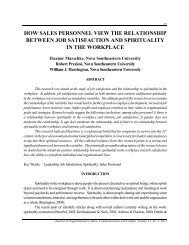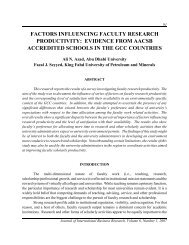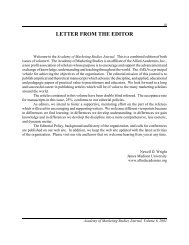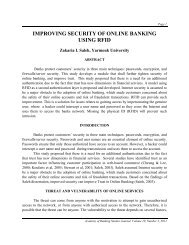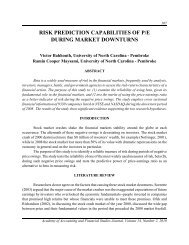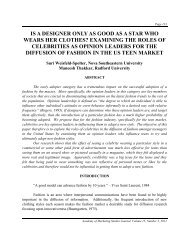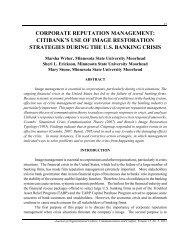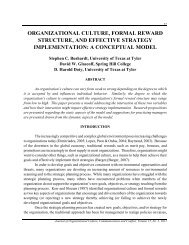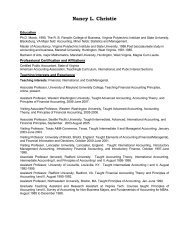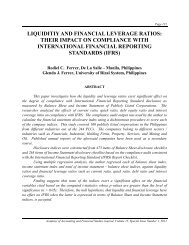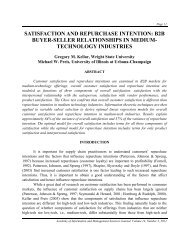Academy of Strategic E-Commerce (ASE) - Allied Academies
Academy of Strategic E-Commerce (ASE) - Allied Academies
Academy of Strategic E-Commerce (ASE) - Allied Academies
Create successful ePaper yourself
Turn your PDF publications into a flip-book with our unique Google optimized e-Paper software.
Volume 6, Number 1 2007<br />
<strong>Allied</strong> <strong>Academies</strong><br />
International Conference<br />
Jacksonville, FL<br />
April 11-14, 2007<br />
<strong>Academy</strong> <strong>of</strong> <strong>Strategic</strong> E-<strong>Commerce</strong><br />
PROCEEDINGS<br />
Volume 6, Number 1 2007
page ii<br />
<strong>Allied</strong> <strong>Academies</strong> International Conference<br />
Jacksonville, 2007 Proceedings <strong>of</strong> the <strong>Academy</strong> <strong>of</strong> <strong>Strategic</strong> E-<strong>Commerce</strong>, Volume 6, Number 1
<strong>Allied</strong> <strong>Academies</strong> International Conference<br />
Table <strong>of</strong> Contents<br />
page iii<br />
OBSTACLES FOR ENTERING E-BUSINESS:<br />
THE GENDER ASPECT ..................................................1<br />
Thomas Poulios, Technological Education Institute <strong>of</strong> Larissa<br />
Anastasios Vasiliadis, University <strong>of</strong> Aegean<br />
OFFSHORE OUTSOURCING – POINT OF NO RETURN. . . . . . . . . . . . . . . . . . . . . . . . . . . . 13<br />
Santosh S. Venkatraman, Tennessee State University<br />
THE IMPACT OF DOMAIN-SPECIFIC STOPWORD<br />
LISTS ON ECOMMERCE WEBSITE SEARCH<br />
PERFORMANCE.......................................................15<br />
Barbara Jo White, Western Carolina University<br />
Jenny Fortier, Western Carolina University<br />
Danial Clapper, Western Carolina University<br />
Pierre Grabolosa, Western Carolina University<br />
Proceedings <strong>of</strong> the <strong>Academy</strong> <strong>of</strong> <strong>Strategic</strong> E-<strong>Commerce</strong>, Volume 6, Number 1 Jacksonville, 2007
<strong>Allied</strong> <strong>Academies</strong> International Conference page 1<br />
OBSTACLES FOR ENTERING E-BUSINESS:<br />
THE GENDER ASPECT<br />
Thomas Poulios, Technological Education Institute <strong>of</strong> Larissa<br />
poulios@teilar.gr<br />
Anastasios Vasiliadis, University <strong>of</strong> Aegean<br />
avasiliadis@rhodes.aegean.gr<br />
ABSTRACT<br />
Women entrepreneurship is an important research field while women have been<br />
underrepresented to the most fields <strong>of</strong> the economy. The present article attempts a first literature<br />
review to the women obstacles in e-business enterprises. Moreover we present the results <strong>of</strong> a<br />
conducted qualitative research for the women’s opinion in net entrepreneurship and the obstacles<br />
that they face. The research confirms what international literature states and shows that women face<br />
more obstacles and problems than men do in entering and developing an e- entrepreneurial life.<br />
This is observed because women should combine family and pr<strong>of</strong>essional life playing different roles,<br />
while they are obliged to face gender stereotypes that are still exist in our society. Future research<br />
should focus on the opinions <strong>of</strong> the entrepreneurs researching them in a quantitative way.<br />
INTRODUCTION<br />
In Amsterdam, the European leaders signed a convention which sets entrepreneurship,<br />
especially women’s entrepreneurship, a basic topic for the union development policy. So, all the<br />
member countries are encouraged to support women to find their own enterprise or to be self<br />
employed. Indeed, all countries tried to go toward this direction, but despite these efforts and the<br />
support <strong>of</strong> the European Union funding there have still been big differences between women and<br />
men entrepreneurship. One <strong>of</strong> the main objectives <strong>of</strong> the European Union is to withdraw the<br />
obstacles that female entrepreneurs face. However, according to Eurostat, the enterprise demography<br />
in the European Union appears to consist <strong>of</strong> important differentiations, according to the gender <strong>of</strong><br />
the entrepreneur (Table 1). Thus, we note that except the retail sector, the hospitality business and<br />
other services, male entrepreneurs hold bigger shares in the entrepreneurship activity. This probably<br />
is due to the obstacles, which female entrepreneurs encounter in the beginning <strong>of</strong> a business activity<br />
or in its development. The international bibliography reports detailed the obstacles that female<br />
entrepreneurs encounter regarding a series <strong>of</strong> parameter such as social comprehension <strong>of</strong><br />
entrepreneurship as well as financial and psychological factors.<br />
Proceedings <strong>of</strong> the <strong>Academy</strong> <strong>of</strong> <strong>Strategic</strong> E-<strong>Commerce</strong>, Volume 6, Number 1 Jacksonville, 2007
page 2<br />
<strong>Allied</strong> <strong>Academies</strong> International Conference<br />
Table 1: Alteration <strong>of</strong> entrepreneurship activities according to gender<br />
Business Sector Male Female Avrg<br />
Industry 10 7 9<br />
Construction 13 9 12<br />
Wholesale 7 6 6<br />
Retail 18 29 21<br />
Hospitality / catering 7 9 8<br />
Repairing 4 1 3<br />
Transportation 6 4 5<br />
Financial Services and Insurance 2 2 2<br />
Business Services 20 17 19<br />
Other Services 13 16 15<br />
100 100 100<br />
According to Carter (2000) there are four main areas <strong>of</strong> questioning economic obstacles that<br />
female entrepreneurs face. The first one concern the diminished ability to detect and utilize<br />
investments start-up funds, the second is the high guarantee that moneylenders demand, the third<br />
one is the lack <strong>of</strong> continuous financing <strong>of</strong> the business and finely, the negative relation between<br />
female entrepreneurs and financial institutions. Indeed, Carter & Rosa, (1998) support that female<br />
entrepreneurs use less start-up funds than male entrepreneurs and this, <strong>of</strong> course, have negative<br />
results.<br />
In addition, the problems that female entrepreneurs face, according to their importance, are<br />
the following:<br />
Lack <strong>of</strong> start-up funds<br />
Lack <strong>of</strong> business development financing<br />
Discrimination by the suppliers<br />
Lack <strong>of</strong> marketing and sales skills<br />
Weakness to enter new markets<br />
Lack <strong>of</strong> management skills<br />
Bureaucracy<br />
Insufficient access to new technologies<br />
Insufficient access to supportive mechanisms<br />
It is remarkable that in the same research, family reasons are reported to prevent the growth<br />
<strong>of</strong> female businesses, such as the inability <strong>of</strong> combining family and business life, the lack <strong>of</strong> places<br />
for child keeping or high costs for all these. Some social obstacles are also pointed out, such as the<br />
perception <strong>of</strong> society for the female entrepreneurship with effect on the diminished opportunities<br />
for the female in contrast the male and the lack <strong>of</strong> trust to the female entrepreneurs.<br />
ICT and its interpenetration from the enterprises<br />
One <strong>of</strong> the main problems for the entrepreneurship development, as mentioned above, is the<br />
weakness to utilize the ICT and there are many researches that, from time to time, have published,<br />
Jacksonville, 2007 Proceedings <strong>of</strong> the <strong>Academy</strong> <strong>of</strong> <strong>Strategic</strong> E-<strong>Commerce</strong>, Volume 6, Number 1
<strong>Allied</strong> <strong>Academies</strong> International Conference page 3<br />
concerning the adoption <strong>of</strong> the information technology and e-business from the enterprises. In most<br />
<strong>of</strong> them, Greece is reported to have lowest performance in many <strong>of</strong> the indices for the adoption <strong>of</strong><br />
Information Technology and e-business development, in comparison to other European countries<br />
as well as to others. For instance, according to research for Å-commerce and the Internet, in<br />
European businesses (Eurostat, 2004), the companies that used personal computers in the year <strong>of</strong><br />
2002 were 94% for the European Union, while for Greece there were 88%. In addition, the<br />
companies that were connected to the Internet were 27% for the EU and 23% for Greece. By doing<br />
an analysis according to the business activity sector, we make sure that the biggest gap is reported<br />
in the tourism sector (hotels and hospitality services in general), where personal computer used in<br />
companies was only 81% in Greece, while in the rest <strong>of</strong> the European Union was 95%. There have<br />
been similar results in the industry sector, where reports reveal much lower percentages, comparing<br />
to similar European enterprises (85% for the Greek enterprises, 93% for the European enterprises).<br />
E-Business<br />
According to a recently published research (e-business-watch, 2005) the enterprises in the<br />
EU that buy products or services online, arise on 51%, from which 24% accomplish more than 5%<br />
<strong>of</strong> their supplies through the Internet. In the same research it appears that the enterprises that sell<br />
their products or their services online constitute a part <strong>of</strong> 17% <strong>of</strong> total, with only 7 % <strong>of</strong> these to<br />
accomplish online sales that would correspond in more than 5% <strong>of</strong> their turnover. In the category<br />
<strong>of</strong> small enterprises having 1 to 9 workers the most, only 15 enterprises out <strong>of</strong> 100 sell online. (Table<br />
2)<br />
Table 2: Internet purchase and sales in the EU<br />
Internet purchase 51%<br />
Internet sales 17%<br />
Source: e-business-watch, 2005 \<br />
In general, it could be mentioned that in the EU, enterprises <strong>of</strong>fer their products to other<br />
companies through the internet to other companies in a percentage <strong>of</strong> 62% and to the consumers<br />
18% (Table 2). From this comes out that the majority <strong>of</strong> the enterprises prefer to do business to<br />
business (B2B) e-commerce and not to sell directly to the consumers (Â2C - business to consumer)<br />
(Table 3).<br />
Table 3: Sales Through the internet – destination<br />
Business (B2B) 62<br />
Consumers (B2C) 18<br />
N/A 20<br />
Source: Eurostat, 2004<br />
Proceedings <strong>of</strong> the <strong>Academy</strong> <strong>of</strong> <strong>Strategic</strong> E-<strong>Commerce</strong>, Volume 6, Number 1 Jacksonville, 2007
page 4<br />
<strong>Allied</strong> <strong>Academies</strong> International Conference<br />
Regarding Small and Medium Enterprises (SMEs), (with personnel till 250 employees) it<br />
could be allegated that the percentages <strong>of</strong> ICT use in Greece are similar to the European average:<br />
Computer ownership 92%, Internet connection 82% and company internet presentation 48% while<br />
the European average for the year 2002 was 94%, 83% and 52% respectively. The percentages <strong>of</strong><br />
the enterprises, which utilize electronic transactions for online VAT, Insurance or TAXIS, are 57%,<br />
50% and 50% respectively. The enterprises that utilize internet transactions run to 34%, for internet<br />
purchases or services 14% and at last for ecommerce just 5% (EDET, 2003).<br />
Reasons for activating through the Internet<br />
Dedhia (2001), Poon & Swatman, (1999) and Chappell & Feindt (1999) reported that e-<br />
business can <strong>of</strong>fer important benefits to small enterprises and these can be the following:<br />
Decrease <strong>of</strong> the operational expenses (Venkatraman, 1994; Poon & Swatman, 1997; Kalakota,<br />
2000; Chappell & Feindt, 1999).<br />
Time saving (Fink, 1998; Chappell & Feindt, 1999; Lancioni, Smith & Oliva, 2000). It is<br />
reported in the eurostat’s (2004) research, that in the EU 65 % <strong>of</strong> the enterprises have access to<br />
the Internet and use it for ebanking compared with a 60 % in Greece.<br />
Customer relationships improvement and the abolition <strong>of</strong> intermediaries (Currie, 1998;<br />
Kalakota, 2000).<br />
Product or service quality improvement (Currie, 2000; Chappell & Feindt, 1999).<br />
Strategy improvement (Poon & Swatman, 1997).<br />
New markets approach (Greaves, Kipling & Wilson, 1999).<br />
Enterprises obstacles to enter the digital economy<br />
<br />
Obstacles to use the ICT<br />
According to ebusinessforum (2002), research about the obstacles that enterprises face in entering<br />
the digital economy, reports that, besides the problems from the use <strong>of</strong> the computer technology and<br />
the necessary skills, there are also problems concerning the technology acquisition costs. The<br />
majority <strong>of</strong> the companies mentioned that they face no problem to adopt ICT (Table 4)<br />
Table 4: SME’s problems to adopt New Technologies in their enterprise<br />
No Problem 44<br />
Computer usage difficulties 9<br />
Special training needed for the use <strong>of</strong> new technology 7<br />
I am not interested / I do not need new technology - computer 5<br />
Big cost 4<br />
Advising absence 3<br />
Skills absence 3<br />
Adaptation difficulties 2<br />
Jacksonville, 2007 Proceedings <strong>of</strong> the <strong>Academy</strong> <strong>of</strong> <strong>Strategic</strong> E-<strong>Commerce</strong>, Volume 6, Number 1
<strong>Allied</strong> <strong>Academies</strong> International Conference page 5<br />
Ignorance <strong>of</strong> the application <strong>of</strong> the new technologies 2<br />
N/A 19<br />
Source: ebusinessforum, 2002<br />
<br />
Companies’ obstacles for adopting e-business<br />
In order to find the obstacles that the small and medium enterprises face entering the digital<br />
economy and especially doing e-commerce, it should be referred to the literature review, that Jones,<br />
Beynon-Davies and Muir (2003) undertook. In this review, the obstacles that SMEs face in order<br />
to adopt e-commerce are reported as follows:<br />
Deficiency <strong>of</strong> financial resources or high installation costs.<br />
Not clear sense <strong>of</strong> time needed to be spent for e-commerce.<br />
Inadequate knowledge or information about the benefits, and also uncertainty <strong>of</strong> the bruit means<br />
Absence <strong>of</strong> specialization in the informatics, inappropriate skills, training and personnel.<br />
Fear and anxiety for security maters.<br />
Competition.<br />
Company’s impotence to adopt e-business.<br />
Legal obstacles.<br />
Obstacles related to the company’s philosophy and culture as well as obstacles related to its<br />
infrastructure.<br />
Management’s absence <strong>of</strong> vision.<br />
Disinclination <strong>of</strong> the employees to utilize new systems.<br />
Priority matter.<br />
The above obstacles that came out from literature were categorized, creating an examination<br />
instrument and an effort was made to record their effect in the SMEs. The research’s results are<br />
reported in the following table (5) with an analysis <strong>of</strong> the company’s size.<br />
Table 5: Companies’ obstacles for adopting e-business<br />
Obstacles Total 1-9 micro 10-49 small 50-250 medium<br />
Lack <strong>of</strong> time to develop and maintain a website 48 53 53 25<br />
Lack <strong>of</strong> special skills (ÉÔ/WWW) 27 36 28 11<br />
Lack <strong>of</strong> financial resources 30 44 31 8<br />
Lack <strong>of</strong> information, consulting and support 15 25 11 6<br />
Lack <strong>of</strong> understanding and trust 13 11 17 8<br />
Organization structure and culture 8 8 8 6<br />
Fear <strong>of</strong> possible ascendancy from the big enterprises 2 0 6 0<br />
Not enough customers or suppliers 28 36 31 8<br />
Concerning for security 25 31 31 6<br />
Not applicable in the company 10 11 11 6<br />
Other 2 0 3 3<br />
Proceedings <strong>of</strong> the <strong>Academy</strong> <strong>of</strong> <strong>Strategic</strong> E-<strong>Commerce</strong>, Volume 6, Number 1 Jacksonville, 2007
page 6<br />
<strong>Allied</strong> <strong>Academies</strong> International Conference<br />
N/A 12 6 14 8<br />
Source: Jones, Beynon-Davies and Muir (2003)<br />
Regarding the problems that Greek enterprises face in order to enter the digital economy, the<br />
working group B3 from the e-businessforum (2002) recorded the following as basic:<br />
Deficient and inadequate information diffusion for ebusiness matters,<br />
The lack <strong>of</strong> specialized human resources,<br />
The very low level <strong>of</strong> sensitisation, know-how and business readiness by the companies’ staff,<br />
The problems deriving from the legal context,<br />
The lack <strong>of</strong> adequate motives,<br />
The lack <strong>of</strong> technological infrastructure in the SMEs for immediate transition into e-commerce,<br />
The inadequate connection <strong>of</strong> research and academic work with the market, in matters <strong>of</strong> new<br />
economy as well as the lack <strong>of</strong> propaganda for e-business.<br />
Investigating the enterprises and referring to the same research, it has to be mentioned that the<br />
problems concern:<br />
The limited resources <strong>of</strong> technological infrastructure <strong>of</strong> the SMEs,<br />
The limited use <strong>of</strong> the informatics, especially in the fields <strong>of</strong> accounting and logistics,<br />
The small and not exactly defined markets.<br />
In addition, in the Eurostat’s (2004) report, it is mentioned that the factors that hold back<br />
Greek enterprises from selling or buying their products online through the Internet, according the<br />
opinion to the entrepreneurs are:<br />
Table 6: Obstacles to enter e-commerce<br />
Companies that not selling Companies selling<br />
through the Internet: (%) through the Internet: (%)<br />
Products not marketable through the internet 34 44<br />
Consumers or other companies not ready yet 47 81<br />
Security problems according to internet payments 43 73<br />
Uncertainty for the legal context 41 75<br />
Accounting problems 24 43<br />
Other obstacles 2 5<br />
Source: Eurostat, 2004<br />
Differences between male and female entrepreneur to enter the digital economy<br />
<br />
New technologies and entrepreneur’s gender<br />
New technologies (information technology), as an important factor <strong>of</strong> the entrepreneurship,<br />
can contribute to entrepreneurship development or shrink <strong>of</strong> many small or big enterprises. The<br />
alteration between male and female entrepreneurs in the use <strong>of</strong> information technology is important<br />
and this is reported in the data <strong>of</strong> the European Observatory for the SMEs (ENSR, 2002). It is<br />
Jacksonville, 2007 Proceedings <strong>of</strong> the <strong>Academy</strong> <strong>of</strong> <strong>Strategic</strong> E-<strong>Commerce</strong>, Volume 6, Number 1
<strong>Allied</strong> <strong>Academies</strong> International Conference page 7<br />
obvious that male entrepreneurs use the information technology much more than their female<br />
colleagues in the enterprises (Table 7) and that, could possibly be, a serious obstacle for further<br />
development.<br />
Table 7: Use <strong>of</strong> new technologies in the company per entrepreneur sex (% <strong>of</strong> the SMEs)<br />
Male Female Difference<br />
Credit Card Reader 34 45 -9<br />
Mobile Phone 84 74 10<br />
Use <strong>of</strong> Computer 70 63 7<br />
Use <strong>of</strong> computer connected to the internet<br />
(with server for use <strong>of</strong> applications<br />
within the company) 50 39 11<br />
E-mail / Electronic Data Interchange (EDI) 72 56 16<br />
Intranet 19 14 5<br />
Internet 75 60 5<br />
Web Site 44 33 11<br />
Non <strong>of</strong> the above 3 6 4<br />
Source: ENSR, 2002<br />
It can be noticed that women entrepreneurs use new technologies less than their male colleagues.<br />
Respectively, there are no significant differences reported in the communication <strong>of</strong> male and female<br />
entrepreneurs with the Public Authorities, with men to communicate a bit more frequently. (Table<br />
8)<br />
Table 8: Use <strong>of</strong> the new technologies: data interchange with the public authorities. (% <strong>of</strong> the SMEs that use<br />
electronic data interchange with the public authorities) per entrepreneur sex<br />
Male Female Difference<br />
Email communication with the public authorities 21 18 3<br />
Gathering information from the public authorities’<br />
web sites 30 27 3<br />
Document download from the public authorities’<br />
web sites 26 21 5<br />
Requested information upload to the public authorities’<br />
web sites 18 15 3<br />
Non <strong>of</strong> the above 60 65 -5<br />
N /A 2 1 1<br />
Source: ENSR, 2002<br />
All <strong>of</strong> the above data demonstrate the imbalance in the use <strong>of</strong> information technology and e-business<br />
between male and female entrepreneurs. In order to investigate further the differences in Greece,<br />
the following qualitative research took place and its results have been analyzed as follows.<br />
Proceedings <strong>of</strong> the <strong>Academy</strong> <strong>of</strong> <strong>Strategic</strong> E-<strong>Commerce</strong>, Volume 6, Number 1 Jacksonville, 2007
page 8<br />
<strong>Allied</strong> <strong>Academies</strong> International Conference<br />
Qualitative research studying the obstacles<br />
The aim <strong>of</strong> the qualitative research was the in-depth study <strong>of</strong> gender differences in the use and<br />
adoption <strong>of</strong> information technologies and especially e-business by the entrepreneurs.<br />
Qualitative research methodology<br />
In order to decide on the sample <strong>of</strong> the research, the theoretical sampling was used, according to<br />
which, individuals or groups are selected for examination based their characteristics and relevance<br />
to the research questions (Mason, 1996). Moreover, the sample <strong>of</strong> the qualitative research was<br />
selected on the base <strong>of</strong> the following catalogue with proportional objectives <strong>of</strong> the qualitative<br />
sampling.<br />
Proportional objectives <strong>of</strong> the qualitative sampling<br />
Total sampling size: 20 Entrepreneurs. The sample contains:<br />
Ten male entrepreneurs, self-employed or with personnel from one to ten employees the most<br />
Ten female entrepreneurs, self-employed or with personnel from one to ten employees the most<br />
Ten entrepreneurs that use information technology<br />
Ten entrepreneurs that don not use information technology<br />
Two male entrepreneurs doing e-commerce<br />
Two female entrepreneurs doing e-commerce<br />
According to the above catalogue, the Qualitative research is held in five female and five male<br />
entrepreneurs through a semi-constructed interview <strong>of</strong> open questions and observation <strong>of</strong> their<br />
business operation. An observation sheet was used while the interview has been recorded.<br />
The axes <strong>of</strong> interview<br />
The researchers produced an interview leaflet containing questions and axes <strong>of</strong> the interview. These<br />
questions were popped out from the international literature review as an exploratory method (Mason,<br />
1996). So, with the qualitative research we tried to examine closely:<br />
The new technology and e-business solutions degree <strong>of</strong> use by the micro enterprises.<br />
The reasons that these enterprises use e-business solutions and the forms they use<br />
The obstacles they face entering the new economy and the ways <strong>of</strong> removing them.<br />
The gender differences in e-entrepreneurship.<br />
Results <strong>of</strong> the qualitative research<br />
The qualitative research confirmed and enriched the data <strong>of</strong> the international literature. The<br />
outcome <strong>of</strong> the research appears that the main reason <strong>of</strong> using the Internet is not to sell or to buy<br />
goods, but it is seen as a means to promote their business. With regard to the obstacles that<br />
entrepreneurs encounter in their entrance into the digital economy, especially in the use and<br />
Jacksonville, 2007 Proceedings <strong>of</strong> the <strong>Academy</strong> <strong>of</strong> <strong>Strategic</strong> E-<strong>Commerce</strong>, Volume 6, Number 1
<strong>Allied</strong> <strong>Academies</strong> International Conference page 9<br />
utilization <strong>of</strong> electronic commerce, qualitative research recorded important points <strong>of</strong> view <strong>of</strong> the<br />
entrepreneurs. Some <strong>of</strong> them consider as the most suspending factor in a small enterprise,<br />
mentioning that «..in order to activate e-commerce you need to invest a lot <strong>of</strong> money» while others<br />
focus on the difficulties in selling a good online, and characteristically pointed out that «… we are<br />
not familiar with the internet yet. It is still difficult in Greece to do e-commerce in comparison to<br />
other countries». A very interesting opinion <strong>of</strong> a female entrepreneur who sells internet services,<br />
mentions:<br />
“… it is difficult to sell services over the internet, but if we have a product we will do it because it<br />
will be so manageable, have no delivery costs, it is downloaded, the client can pay for it and it is<br />
over. We promote the product, the client can go to the site and see it, and they call us to ask about<br />
it and to order. There is not an e-paying process, it is a part <strong>of</strong> e-commerce but we have not operate<br />
it yet.”<br />
Additional reasons that deter a micro-enterprise to expand to electronic commerce are reported as<br />
follows:<br />
The ignorance <strong>of</strong> the e-commerce and information technology by entrepreneurs<br />
The lack <strong>of</strong> knowledge about entrepreneurship matters<br />
The different demands that an internet company has, compared to a traditional one<br />
The difference in the cost accounting <strong>of</strong> products<br />
The lack <strong>of</strong> market research before activating the internet<br />
The fact that the entrepreneurs are not ready to pay more for changes in their business in order<br />
to build a successful e-commerce site<br />
Except for the reasons above, personal characteristics <strong>of</strong> the entrepreneur and his or her personal<br />
targets set play an important role.<br />
«…The clients think that they will make a fortune with e-commerce, which does not happens<br />
from one day to another, they get disappointed and leave it. While others work on that,<br />
follow it, work for the ecommerce operations, conceptualize the potential <strong>of</strong> ecommerce, they<br />
stay and continue».<br />
As for the differences in gender reported I relation to their entrance in the digital economy, the<br />
research shows that female entrepreneurs encounter bigger problems than the male ones. In the<br />
beginning it is stated that «… men use the technology much more. Women take care more <strong>of</strong> the<br />
customer, are more communicative and perceive the matters better». The absence <strong>of</strong> the personal<br />
contact between the customer and the salesperson is more against the women. It is pointed out that<br />
female have less time to dedicate to the development <strong>of</strong> an electronic business as they have multiple<br />
roles in society (family, wife, motherhood) and this constitutes an important obstacle against the<br />
electronic entrepreneurship. From all the above, we can find out that the qualitative research<br />
confirms the research data <strong>of</strong> the international literature, according to the obstacles that<br />
entrepreneurs encounter entering the digital economy, especially the female ones.<br />
CONCLUSIONS<br />
Proceedings <strong>of</strong> the <strong>Academy</strong> <strong>of</strong> <strong>Strategic</strong> E-<strong>Commerce</strong>, Volume 6, Number 1 Jacksonville, 2007
page 10<br />
<strong>Allied</strong> <strong>Academies</strong> International Conference<br />
The present research study emerge the problem coming out <strong>of</strong> the use <strong>of</strong> the information<br />
technology between male and female users. Especially, it is focused on the obstacles that male and<br />
female encounter in order to enter the digital economy. It is reported that this matter is extremely<br />
important and constitutes a field on which considerable differences are reported over male and the<br />
weakness <strong>of</strong> female to follow the progress in this section. As a conclusion, we could support that<br />
micro enterprises encounter many and important obstacles in their total entry in digital economy.<br />
As confirmed from literature review that came out before, as well as from the qualitative research,<br />
the problems and obstacles that the entrepreneurs face in the use and utilization <strong>of</strong> the ICT, seems<br />
to be the same in all over the world. Thus, it is important for the government, the international<br />
community and organizations to take actions in order to eliminate the obstacles that set back the<br />
development <strong>of</strong> entrepreneurship as well as the development <strong>of</strong> society in general.<br />
FUTURE RESEARCH<br />
The present study is one <strong>of</strong> the first efforts that defines the field <strong>of</strong> female e-entrepreneurship<br />
and its obstacles. So, future research should be focused on male and female opinion differences.<br />
Consequently, this effort should be continued, carrying out a quantitative research <strong>of</strong> this matter,<br />
especially placing emphasis on the relation between the e-business and the obstacles that<br />
entrepreneurs face, as well as their proposed solutions.<br />
REFERENCES<br />
Å-business-watch, (2005), A pocketbook <strong>of</strong> e-business indicators, European Commission Enterprise<br />
– Industry Directorate General, Luxembourg<br />
ebusinessforum (2002) The use <strong>of</strong> the Information Computer Technologies (ICT) from the SMEs,<br />
accessed on 15/7/2005 in www.ebusinessforum.gr<br />
Ebusiness-watch (2004) The European e-Business Report 2004 edition A portrait <strong>of</strong> e-business in<br />
10 sectors <strong>of</strong> the EU economy, European Commission Enterprise – Industry Directorate<br />
General, Luxembourg<br />
Eurostat (2004) E-commerce and the internet in European businesses- 2002, European Commission<br />
Jones, P., Beynon-Davies, P. and Muir, E. (2003) Ebusiness barriers to growth within the SME<br />
sector, Journal <strong>of</strong> Systems & Information Technology, 7(1).<br />
ENSR, 2002, Observatory <strong>of</strong> European SMEs - Business demography in Europe 2002 / No 5,<br />
European Commission.<br />
Working Group Â3 ebusinessforum (2002) The regional approach <strong>of</strong> enterprise transition policy to<br />
the digital economy, article published on web www.ebusinessforum.gr<br />
Jacksonville, 2007 Proceedings <strong>of</strong> the <strong>Academy</strong> <strong>of</strong> <strong>Strategic</strong> E-<strong>Commerce</strong>, Volume 6, Number 1
<strong>Allied</strong> <strong>Academies</strong> International Conference page 11<br />
Dedhia, N. (2001). E-commerce Quality Management, 12(3), 397-402. in Jones, P., Beynon-Davies,<br />
P. and Muir, E. (2003) Ebusiness barriers to growth within the SME sector, Journal <strong>of</strong><br />
Systems & Information Technology, 7(1).<br />
Mason, J. (1996). Qualitative researching, Sage Publications.<br />
National Network <strong>of</strong> Research and Technology (NNRT), (2003), Research for the use <strong>of</strong><br />
Information Computer Technologies (ICT) from the Greek SMEs, accessed 15/7/2006 in<br />
www.ebusinessforum.gr.<br />
National Network <strong>of</strong> Research and Technology (NNRT), (2005) Study – research recording the<br />
infiltration <strong>of</strong> ebusiness practices in the big Greek enterprises through repeated interviews<br />
with executives from information technology departments – a comparative presentation <strong>of</strong><br />
the research findings 2003 – 2004, Economic University <strong>of</strong> Athens.<br />
Poon, S. & Swatman, P. (1999). An exploratory study <strong>of</strong> small business Internet <strong>Commerce</strong> issues.<br />
Information and Management, 35(1), 9-18. in Jones, P., Beynon-Davies, P. and Muir, E.<br />
(2003) Ebusiness barriers to growth within the SME sector, Journal <strong>of</strong> Systems &<br />
Information Technology, 7(1).<br />
Chappell, C. & Feindt, S. (1999). Analysis <strong>of</strong> E-commerce practice in SMEs. Kite Project,<br />
submitted. in Jones, P., Beynon-Davies, P. and Muir, E. (2003) Ebusiness barriers to growth<br />
within the SME sector, Journal <strong>of</strong> Systems & Information Technology, 7(1).<br />
Venkatraman, N. (1994). IT enabled business transformation: from automation to business scope<br />
definition. Sloan Management Review, December, 73-87 in Jones, P., Beynon-Davies, P.<br />
and Muir, E. (2003) Ebusiness barriers to growth within the SME sector, Journal <strong>of</strong> Systems<br />
& Information Technology, 7(1).<br />
Kalakota, R. (2000). Next generation b2B solutions: the revolution’s winners. Supply chain<br />
Management Review, July/August, 14-79. in Jones, P., Beynon-Davies, P. and Muir, E.<br />
(2003) Ebusiness barriers to growth within the SME sector, Journal <strong>of</strong> Systems &<br />
Information Technology, 7(1).<br />
Fink, D. (1998). Guidelines for the Successful Adoption <strong>of</strong> Information Technology in Small &<br />
Medium Enterprises, International Journal <strong>of</strong> Information Management, Vol. 16, No 4, 243-<br />
253. in Jones, P., Beynon-Davies, P. and Muir, E. (2003) Ebusiness barriers to growth within<br />
the SME sector, Journal <strong>of</strong> Systems & Information Technology, 7(1).<br />
Lancioni, R., Smith. M. & Oliva, T. (2000). The role <strong>of</strong> the Internet in supply chain management,<br />
Industrial Marketing Management, 29(1), 45-46. in Jones, P., Beynon-Davies, P. and Muir,<br />
Proceedings <strong>of</strong> the <strong>Academy</strong> <strong>of</strong> <strong>Strategic</strong> E-<strong>Commerce</strong>, Volume 6, Number 1 Jacksonville, 2007
page 12<br />
<strong>Allied</strong> <strong>Academies</strong> International Conference<br />
E. (2003) Ebusiness barriers to growth within the SME sector, Journal <strong>of</strong> Systems &<br />
Information Technology, 7(1).<br />
rd<br />
Currie, W. (1998). ‘Electronic <strong>Commerce</strong>: the new paradigm for business’ 3 UKAIS conference,<br />
University <strong>of</strong> Lincoln, McGraw Hill. in Jones, P., Beynon-Davies, P. and Muir, E. (2003)<br />
Ebusiness barriers to growth within the SME sector, Journal <strong>of</strong> Systems & Information<br />
Technology, 7(1).<br />
Greaves, C. Kipling, P. & Wilson, T. (1999). Business use <strong>of</strong> the world wide web, with particular<br />
reference to UK companies. International Journal <strong>of</strong> Information Management, 19(6), 449-<br />
470. in Jones, P., Beynon-Davies, P. and Muir, E. (2003) Ebusiness barriers to growth within<br />
the SME sector, Journal <strong>of</strong> Systems & Information Technology, 7(1).<br />
Poon, S. & Swatman, P. (1999). An exploratory study <strong>of</strong> small business Internet <strong>Commerce</strong> issues.<br />
Information and Management, 35(1), 9-18. in Jones, P., Beynon-Davies, P. and Muir, E.<br />
(2003) Ebusiness barriers to growth within the SME sector, Journal <strong>of</strong> Systems &<br />
Information Technology.<br />
Jacksonville, 2007 Proceedings <strong>of</strong> the <strong>Academy</strong> <strong>of</strong> <strong>Strategic</strong> E-<strong>Commerce</strong>, Volume 6, Number 1
<strong>Allied</strong> <strong>Academies</strong> International Conference page 13<br />
OFFSHORE OUTSOURCING – POINT OF NO RETURN<br />
Santosh S. Venkatraman, Tennessee State University<br />
svenktra@yahoo.com<br />
INTRODUCTION<br />
The American information technology industry has seen a steady erosion <strong>of</strong> its workforce<br />
over the last 10 years due to <strong>of</strong>fshore outsourcing. Much <strong>of</strong> the lost jobs have been in the help desk,<br />
database administration, and small application development areas. According to Forrester Research,<br />
in 2005, about 24% <strong>of</strong> North American companies used <strong>of</strong>fshore providers to meet some <strong>of</strong> their<br />
s<strong>of</strong>tware needs, according. The pace <strong>of</strong> outsourcing is not abating any time soon – IDC studies have<br />
suggested that over the next five years, spending on <strong>of</strong>fshore IT services is set to increase at a<br />
compound annual growth rate <strong>of</strong> 18%. The common conclusion drawn by many is that <strong>of</strong>fshore<br />
outsourcing is bad for our nation’s economy and the job market. While the loss <strong>of</strong> jobs is indeed<br />
real, outsourcing has enormously benefited numerous American organizations – but only those that<br />
have understood the many advantages and opportunities created by outsourcing.<br />
The purpose <strong>of</strong> this paper is to identify the reasons that make <strong>of</strong>fshore outsourcing not only<br />
a compelling option but also a necessary strategy for successfully competing in the global economy.<br />
REASONS FOR OUTSOURCING<br />
Outsourcing is the practice <strong>of</strong> relocating a whole process, a piece <strong>of</strong> a process, a function,<br />
or a discrete piece <strong>of</strong> work outside <strong>of</strong> its own corporate boundaries [Bernstein 2005]. Companies<br />
seeking to focus their management, workforce, capital, and other resources on their "core<br />
competencies" examine their business processes for work that can be performed effectively and costadvantageously<br />
outside the company while preserving the company's competitive strengths and<br />
maximizing financial gain. These business processes include accounting, human resources<br />
management, call centers, research, and information technology operations. Offshore outsourcing<br />
(or Offshoring) refers to outsourcing <strong>of</strong> an activity to an organization that is located in a different<br />
country.<br />
In the current global economy, outsourcing is <strong>of</strong>ten more the norm for large US<br />
organizations, rather than the exception. The best run companies leverage outsourcing to maximize<br />
their competitive advantage.<br />
Reduced cost <strong>of</strong> Operation. The allure <strong>of</strong> reduced operating costs is one <strong>of</strong> the original compelling<br />
reasons for <strong>of</strong>fshore outsourcing. The difference in labor costs was simply too good to pass up.<br />
Staff Scalability. The global economy, while providing more opportunities, also increases the<br />
volatility <strong>of</strong> the business environment. The sudden changes in market conditions allow outsourcers<br />
to rapidly vary the size <strong>of</strong> their workforce.<br />
Proceedings <strong>of</strong> the <strong>Academy</strong> <strong>of</strong> <strong>Strategic</strong> E-<strong>Commerce</strong>, Volume 6, Number 1 Jacksonville, 2007
page 14<br />
<strong>Allied</strong> <strong>Academies</strong> International Conference<br />
Access to Global Employee Skills. It is not easy, nor cheap for a country to develop all the skills<br />
necessary to thrive in a global economy. It is far more efficient to simply acquire the available skills<br />
by hiring employees with the required skill sets from any part <strong>of</strong> the globe. Some <strong>of</strong> the current<br />
favorite places include India, China, and the Central/Eastern European regions.<br />
Time Zone differences. This allows 24/7 operations, in which work can be handed over to a center<br />
in a different time zone (as the work day ends in one zone), so that business operates continuously<br />
without any interruptions or incurring overtime payments.<br />
First to Market. An organization can attain competitive advantage by selectively outsourcing<br />
specific IT and business processes. First, by using global resources in an optimal fashion, an<br />
organization can be the first to market a product or service. This would allow for an initial<br />
advantage, and give the company the opportunity to quickly corner the market.<br />
Market Expansion. By outsourcing to <strong>of</strong>fshore centers, an organization gets an opportunity to learn<br />
about local markets in various parts <strong>of</strong> the planet. This allows the company to expand its current<br />
business in other markets, or even identify new opportunities for businesses and services.<br />
Focused and improve core competencies. By outsourcing non-core business processes, the<br />
distractions associated with dealing with non-core operations and processes are removed. This<br />
allows an organization to focus and improve on its core competencies. It is also possible that the<br />
outsourced jobs are done more efficiently at a lower cost.<br />
Timely Customer Service. Last, but not least, an organization can provide a lower costing, and a<br />
higher quality customer service experience by globally outsourcing call centers. It is essential that<br />
the outsourced call-centers are reliable, well trained, and <strong>of</strong> high quality (Dell had recent problems<br />
when it did not do this).<br />
SUMMARY & CONCLUSIONS<br />
In the near future there will probably be no large organization that is solely based in one<br />
country. Each organization will maximize their efficiency by carrying out different business<br />
processes in the most cost-efficient geographic regions. This will be an essential strategy to survive<br />
and thrive in the new global world. In essence, the outsourcing juggernaut cannot be stopped now,<br />
and more importantly should not be stopped. There is no return to closed, protectionist economies.<br />
Available Upon request<br />
REFERENCES<br />
Jacksonville, 2007 Proceedings <strong>of</strong> the <strong>Academy</strong> <strong>of</strong> <strong>Strategic</strong> E-<strong>Commerce</strong>, Volume 6, Number 1
<strong>Allied</strong> <strong>Academies</strong> International Conference page 15<br />
THE IMPACT OF DOMAIN-SPECIFIC STOPWORD<br />
LISTS ON ECOMMERCE WEBSITE SEARCH<br />
PERFORMANCE<br />
Barbara Jo White, Western Carolina University<br />
whiteb@email.wcu.edu<br />
Jenny Fortier, Western Carolina University<br />
jf45017@wcu.edu<br />
Danial Clapper, Western Carolina University<br />
clapper@email.wcu.edu<br />
Pierre Grabolosa, Western Carolina University<br />
pgrabolosa@email.wcu.edu<br />
Shoppers on eBay log more than 400 million searches per day for any one <strong>of</strong> more than 25<br />
million available products. Search time is an important determinant <strong>of</strong> e-service quality, which is<br />
widely recognized as an important determinant <strong>of</strong> a customer’s electronic commerce (e-commerce)<br />
experience. One factor contributing to a negative experience is long waiting times. In fact,<br />
consumers have a tendency to abandon slow websites if waiting time becomes intolerable, which<br />
can occur in as little as two seconds. Much like an index in the back <strong>of</strong> a book facilitates searching,<br />
a similar index, called an inverted index, facilitates searching in a digital environment. Smaller<br />
indexes result in faster searches. One way to accelerate search time is to reduce the index size by<br />
removing common words like the, and,” or with. These words, called “stopwords,” <strong>of</strong>fer little<br />
searchable meaning. Words on standard stopword lists are frequently removed from indexes.<br />
However, e-commerce sites also contain high-frequency, low-value words that are domain-specific<br />
and should be added to standard stopword lists. For example, high frequency words in eBay’s<br />
furniture category include please, shipped, damaged, auction, charged, accept, buy, and paying.<br />
These are high-frequency words buyers don’t tend to search for.<br />
To assist in the creation <strong>of</strong> our domain-dependent stopword list, we first created a corpus<br />
<strong>of</strong> over 36,000 eBay products in the furniture category and then used linguistic analysis to drive the<br />
stopword list algorithm. We tested our domain-dependent stopword list against a standard stopword<br />
list and a control group. We experimentally generated furniture category queries and executed a<br />
random set <strong>of</strong> these queries against the three indexes and recorded the search times. A repeatedmeasures<br />
ANOVA was used to analyze results. The queries tested using the domain-dependent index<br />
performed nearly 5.6% faster than the same queries run against the index with a standard list <strong>of</strong><br />
stopwords removed, and nearly 20% faster than the control index with no stopwords removed. The<br />
effect <strong>of</strong> the index size was significant [F(1.061, 33.945)=3.761, p=.059] at an alpha level <strong>of</strong> .10.<br />
Paired T-Tests were also conducted and showed that the times (in milliseconds) for queries run<br />
against the domain-dependent index were significantly faster than both those run against the index<br />
with the standard set <strong>of</strong> stopwords removed [t(32)=1.996, p=.055] and those run against the index<br />
with no stopwords removed [t(32)=1.999, p=.054].<br />
Proceedings <strong>of</strong> the <strong>Academy</strong> <strong>of</strong> <strong>Strategic</strong> E-<strong>Commerce</strong>, Volume 6, Number 1 Jacksonville, 2007
page 16<br />
<strong>Allied</strong> <strong>Academies</strong> International Conference<br />
This study makes several important contributions to the ecommerce field. First, the study<br />
uses a large corpus <strong>of</strong> nearly 20 million words comprising just over 36,000 products from eBay, an<br />
important ecommerce website. Second, it considers the language that consumers use in the online<br />
auction marketplace when implementing techniques that accelerate website searches as the<br />
stopword list algorithm is based on a linguistic analysis <strong>of</strong> consumer-provided product listings.<br />
References available upon request.<br />
Jacksonville, 2007 Proceedings <strong>of</strong> the <strong>Academy</strong> <strong>of</strong> <strong>Strategic</strong> E-<strong>Commerce</strong>, Volume 6, Number 1
<strong>Allied</strong> <strong>Academies</strong> International Conference page 17<br />
Proceedings <strong>of</strong> the <strong>Academy</strong> <strong>of</strong> <strong>Strategic</strong> E-<strong>Commerce</strong>, Volume 6, Number 1 Jacksonville, 2007




